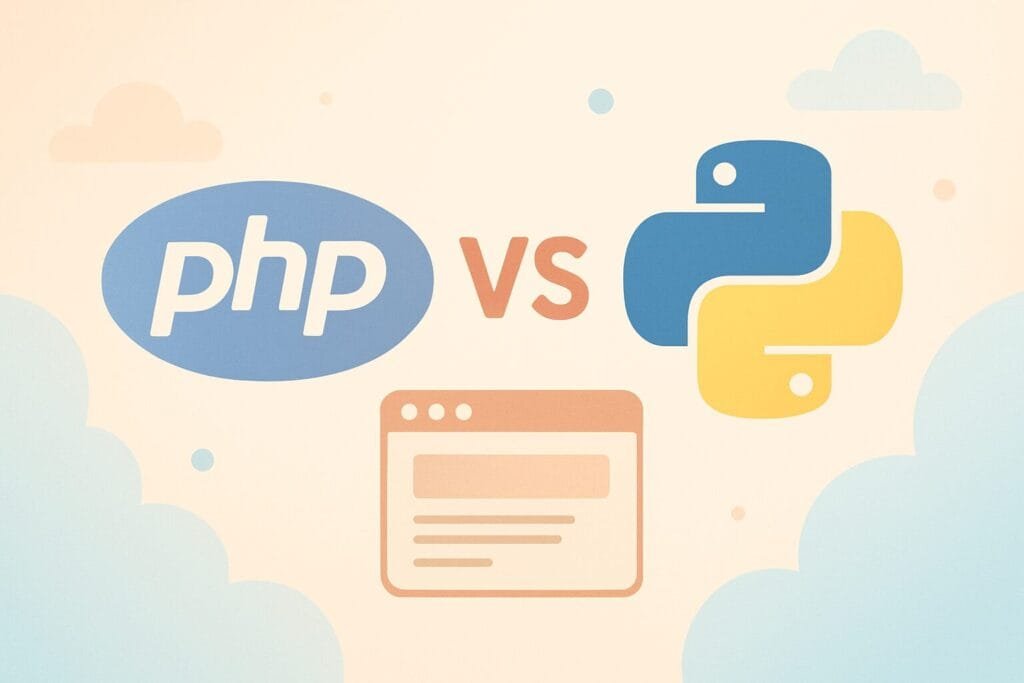When it comes to web application development, two of the most popular programming languages are PHP and Python. Both are widely used across the globe, each with unique strengths, communities, and ecosystems. Choosing between PHP and Python can be challenging, especially for startups, businesses, or developers looking to build scalable, secure, and modern web apps.
In this article, we will explore the main differences between PHP and Python, comparing their performance, scalability, frameworks, community support, learning curve, and use cases. By the end, you will have a clearer picture of which language best suits your web development needs.

Overview of PHP
PHP (Hypertext Preprocessor) is a server-side scripting language designed specifically for web development. It powers a large portion of the internet, including popular platforms like WordPress, Joomla, and Drupal. Known for its simplicity and integration with databases like MySQL, PHP remains a go-to option for small to medium-sized projects.
Overview of Python
Python is a general-purpose programming language that emphasizes readability, simplicity, and versatility. Unlike PHP, Python was not originally created for the web, but its frameworks such as Django and Flask have made it a top choice for web applications. Python also excels in fields like machine learning, artificial intelligence, and data science, making it a flexible language for diverse projects.
PHP vs Python: Detailed Comparison
Here is a side-by-side comparison to better understand the strengths and weaknesses of both languages:
| Criteria | PHP | Python |
|---|---|---|
| Performance | Optimized for web; faster execution for basic scripts | Efficient for complex applications, slightly slower for simple tasks |
| Frameworks | Laravel, CodeIgniter, Symfony | Django, Flask, FastAPI |
| Scalability | Good for small to medium web apps | Highly scalable, used in large applications like Instagram |
| Community Support | Huge community, especially in CMS and web hosting | Growing community, strong support in AI and data science |
| Learning Curve | Beginner-friendly for web development | Very easy to learn; clean and simple syntax |
| Use Cases | Content management systems, eCommerce sites | AI-driven apps, enterprise solutions, APIs |
When Should You Use PHP?
- If you need to build a content-heavy website using WordPress, Joomla, or Drupal
- When your project involves eCommerce platforms like WooCommerce or Magento
- If your hosting environment already supports PHP out-of-the-box
- When you are developing a project that requires quick setup and low cost
When Should You Use Python?
- If you plan to integrate machine learning or AI features into your web app
- When building highly scalable apps like social networks or SaaS platforms
- If your project demands clean, maintainable, and future-proof code
- When APIs and backend services are the main focus of the application
Popular Companies Using PHP and Python
Many well-known companies rely on PHP and Python for their web applications:
- PHP: Facebook (initially built with PHP), WordPress.com, Wikipedia
- Python: Instagram, Spotify, Dropbox
Which Language Should You Choose?
The choice between PHP and Python depends on your project requirements:
- For quick deployment, content-heavy platforms, or CMS-based websites, PHP is still a solid choice.
- For long-term scalability, integration with AI/ML, or enterprise-level apps, Python is the better option.
It’s important to note that both languages are mature, widely used, and well-documented. The final decision comes down to project goals, budget, and the expertise of your development team.
Final Thoughts
Both PHP and Python are excellent languages for web app development. PHP shines in traditional web environments, especially with content-driven sites, while Python stands out in modern applications that leverage AI, APIs, and large-scale systems.
If you are still unsure, a good approach is to explore more in-depth comparisons from trusted developer resources to align your decision with the latest industry practices.
Ultimately, the best language is the one that fits your project’s goals, timeline, and future growth.

